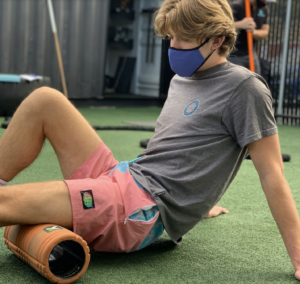Foam Rolling for Exercise Performance
Foam rolling has become a common practice in exercise training. Everyone seems to be using this tool in sport, gym, or other athletic settings. The method is done by using ones own body weight to apply pressure to tight or sore muscles.
Foam rolling is thought to improve muscular performance and flexibility as well as to alleviate muscle fatigue and soreness. For this reason, foam rolling has become a popular intervention in all kinds of sport settings used to increase the efficiency of training or competition preparation as well as to speed post-exercise recovery.
Studies conclude that foam pre-exercise foam rolling will improve performance and strength, while post-exercise foam rolling will reduce muscle soreness and improve flexibility.
What Really Happens When You Foam Roll?
In all of our muscles, we have different kinds of mechanoreceptors. These receptors respond to different stimuli placed upon a muscle. A mechanoreceptor found in the tendons of muscles are the Golgi tendon organelles which are sensitive to a change in muscle tension.
Foam rolling stimulates a Golgi tendon organelles in response to the pressure applied to muscle tissue by the roller. Once tension is placed upon the muscle, the Golgi tendon organelles inhibit further muscle contraction to prevent muscle damage. This physiological response helps tight muscles become inhibited, or released, which can relieve pain and create better movement patterns by increasing range of motion.
It also helps create optimal length-tensions relationships in a muscle. Length-tension relationships state that when a muscle is too short or too long, the actin and myosin filaments will be at a disadvantage to for contracting which results in reduced strength. When actin and myosin filaments are lined up optimally, which occurs when a muscle is not too long or too short, extra force from a muscle contraction can take place. In short, releasing tight muscles helps prepare for optimal performance.
Foam rolling may also reduce adhesions that are present in the fascia surrounding muscles. Fascia is connective tissue that surrounds the body. When there is a lack of movement, adhesions can form around that can restrict movement even more. Adhesions between muscles prevent glide between the structures and lead to a decreased range of motion or pain.
Foam Rolling Before a Personal Training Session

Should I Use a Percussion Gun or Foal Roller?
Evidence shows that both foam rolling and percussion guns yield beneficial results of pain relief and relaxation. Depending on how much work you’d like to put into your homework for pain management at home, we’d love to design a recovery or rehabilitation routine for you!
Technology has given us amazing tools such as the percussion gun, which we love so much. We love it so much that we designed one for you too!
We offer personal massage guns online at;
https://www.danmelita.com/product/massage-gun/
Fun Fact: Vibration therapy and massage are equally effective in prevention of DOMS. Massage is effective in restoration of concentric strength (1 RM). Yet vibration therapy shows clinically early reduction of pain and is effective in decreasing the level of LDH in 48 hours post exercise periods.
Written by Becca Petit and Danielle Barker
